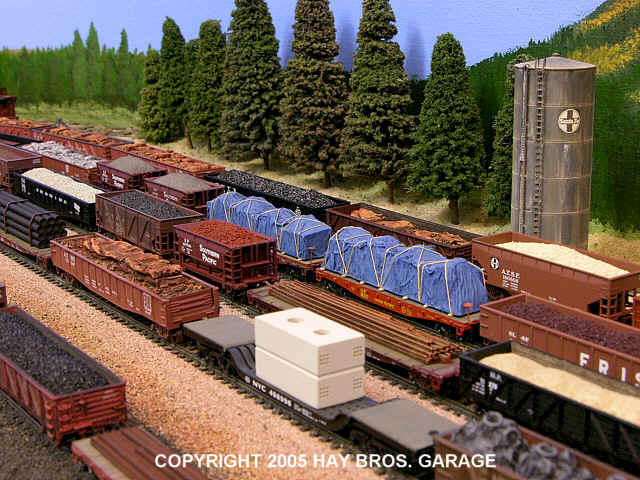
TIPS AND TRICKS FROM VERNE
There are many methods that can be used to modify our products. Our goal is to provide loads that are detailed enough to use as is, but that could look even more realistic with some additional detail painting. Rather than add additional detail painting steps into the manufacturing process, our philosophy is to hold the final cost down and let the end user "personalize" the load to his or her liking if they desire to do so.
This page has been added to share a few "Tips and Tricks" that we have received from end users of our products. If you have any methods to share please feel free to contact us.
-------------------------------------------------------------------------------------------------------------------------
Tips
for Modeling Loads
Basic tips for using Hay
Bros. Garage model loads
by Verne Niner

Tip
1: Hay Bros. Garage loads are the most realistic loads available anywhere!
One of the most
enjoyable aspects of our hobby is the fun of creating the illusion of a
miniature transportation system at work. I
always find loaded cars attention-getters, and fun to create.
Hay Bros. Garage loads are a great way to load your open cars with unique
loads that add interest and realism. They
have a number of features that make working with them a pleasure:
While Hay Bros.
Garage loads look great right out of the package, a few extra steps can really
enhance your car and the load it carries. All
you need is a few evenings, some simple tools, and basic materials (most of
which you probably already have). Model
loads are perfect ‘first projects’ to gain experience working with N scale
models, and yet can provide challenges for advanced modelers as well.
The examples in this article are all N scale loads, but the same
techniques can be used for most HO and Z scale loads.
So, let’s get started!
Hopper Cars
Hopper cars are
one of the most common types of cars found on most railroads.
They haul coal, gravel, ballast, sand, wood chips, recycled glass, and
other bulk products that can be hauled in the open.
The fun in modeling hoppers is to simulate a loaded car that looks like
it has been hauling many such loads over its service lifetime.
The trick here is to do some simple weathering to simulate the dust and
spilled material that would streak the sides and top edges of the car.
The most common
bulk commodity hauled in hoppers is coal. There
are many different kinds of coal hauled, each with a different texture and
appearance. Hay Bros. Garage has
many different loads simulating lump and fine coal for popular car types, with
different-shaped load profiles to provide variety.
Representing a
hopper car hauling coal is as simple as weathering the car, and placing the load
in it. Much has been published
about how to weather freight cars, so we won’t go into the details here.
See Rich Yourstone’s article “The Art of Weathering” in the
July-August 2004 N Scale Railroading magazine for his excellent weathering tips.
One additional bit of advice: look at real cars, or color photos of the
prototype, to get weathering inspiration and ideas.
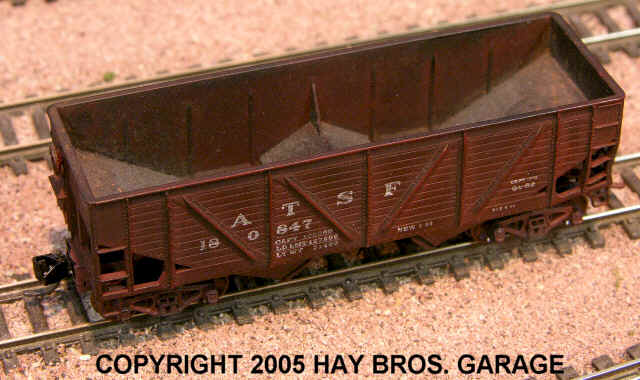
Tip 2: Weathered interior of hopper car
Don’t forget
to weather the inside of the car as well, to simulate coal dust and scratches
left from loading and unloading the car. Many
hoppers have virtually no paint on the inside edges, where constant abrasion
from loading and unloading eventually strip the finish away.
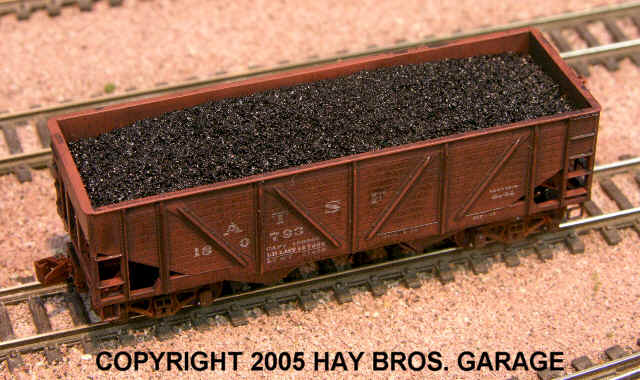
Tip 3: Finished hopper car with coal load
The texture on
these loads is so realistic, it can often fool visitors.
It’s fun to watch visitors poke the load with their finger to see if
the material is loose!
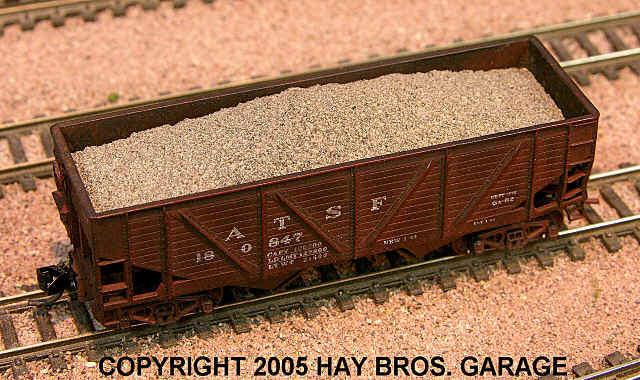
Tip 4: Finished hopper car with gravel load
Another common
load hauled in hoppers is gravel. For
this load, I used a Hay Bros. Garage gravel load, with a thin wash of Polly S
Engine Black to help bring out the texture.
Gondola Cars
Gondola cars can
haul almost any bulk commodity plus other items including structural steel,
lumber, machinery, railroad ties, scrap, pipe, old tires, and virtually anything
else. Hay Bros Garage has many
loads available for popular gondola cars.
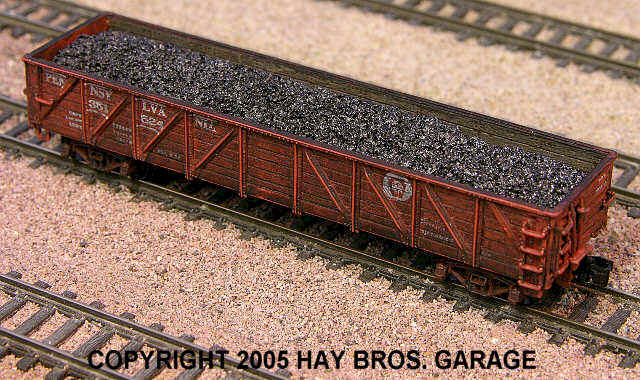
Tip 5: Composite gondola with metallurgical coke
load
An easy bulk
load to simulate is metallurgical coke, which is used in making steel. It
is a common load seen around steel mills, or enroute to remote foundries.
I used a Hay Bros. Garage load in an Intermountain 40’ composite
gondola to simulate a load of coke headed for a west coast foundry.
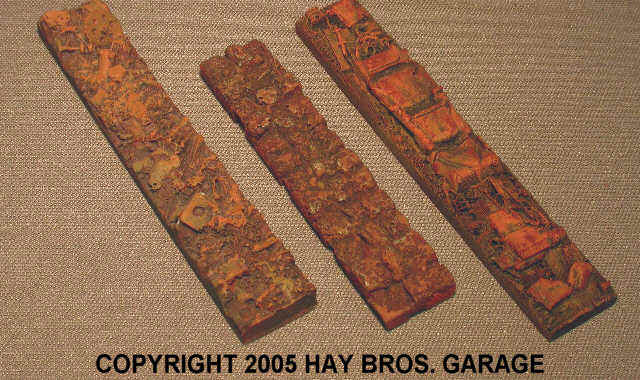
Tip 6: Variety of scrap loads available
Some of my
favorite Hay Bros. Garage loads are the variety of scrap loads.
Here are three favorites, loose scrap, bundles of scrap metal, and loose
scrap with old cars. They are real
attention-getters!
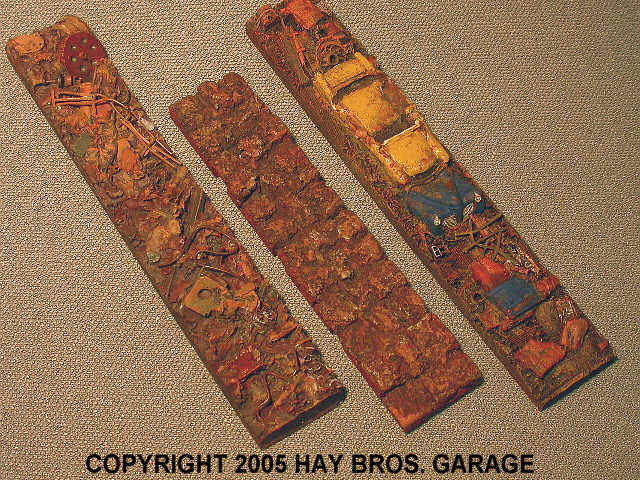
Tip 7: Highlight details with variations in color,
using a fine brush
The loads come
in a very realistic rust patina, but a little time with different shades of
rust, black and gray can really bring out their amazing detail – and increase
their realism even more. Here are
the same loads after highlighting the details, and adding a few bits of scrap.
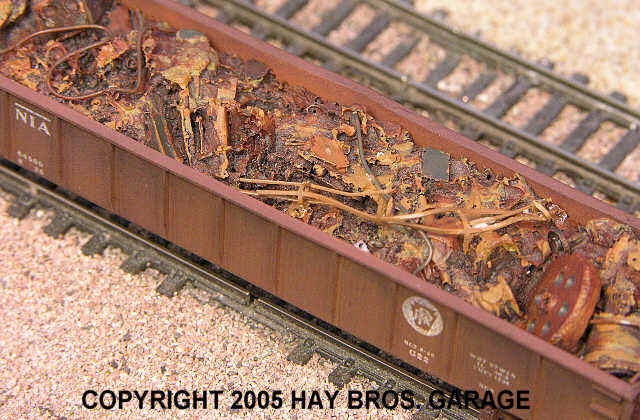
Tip 8: Add loose scrap to add extra relief and
texture
Another favorite
trick is to add bits of wire and scrap to the already fine detail, to clinch the
illusion of loose scrap laying in the car. I used scrap etched metal parts, wire and bits of styrene to
simulate additional scrap with open spaces between them and the cast load.
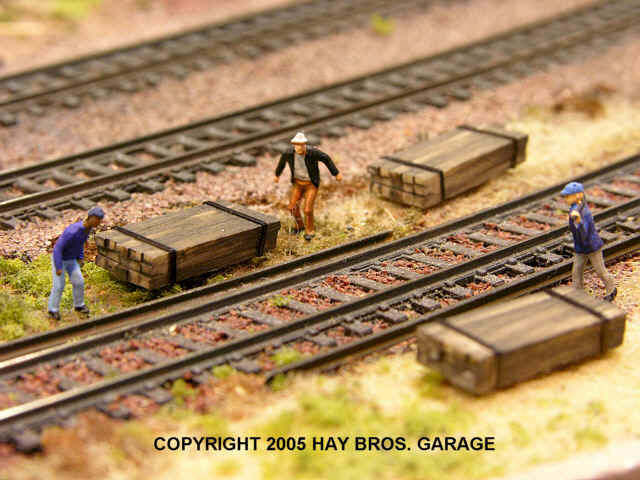
Tip 9: Tie bundle loads
Tie bundles are
a common sight where ties are being replaced, and as a load.
The Hay Bros. Garage tie bundles follow Union Pacific prototype practice,
but are appropriate for many roads. They
can be stacked inside a gondola, or set along the right of way as scenic
details.
Flat Cars
Flat cars are
the ideal car for showing off unique loads.
Hay Bros. Garage makes a wide variety of covered loads, including
machinery, military equipment, and covered bales.
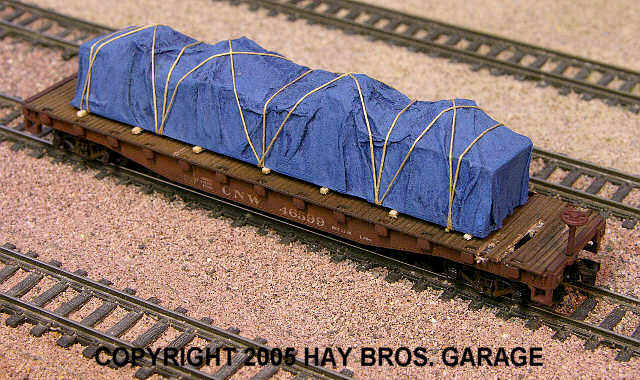
Tip 10: Flatcar with covered load
While the
covered loads come available in different colors, I like to vary the color of
the canvas for some loads. Start by
staining the load with thinned acrylic paint, and avoid loading up the fine
texture with too much paint. Once
the load is dry, use darker shades to add relief to shadows, and lighter shades
for highlights on the top of folds in the fabric.
This adds greatly to the illusion.
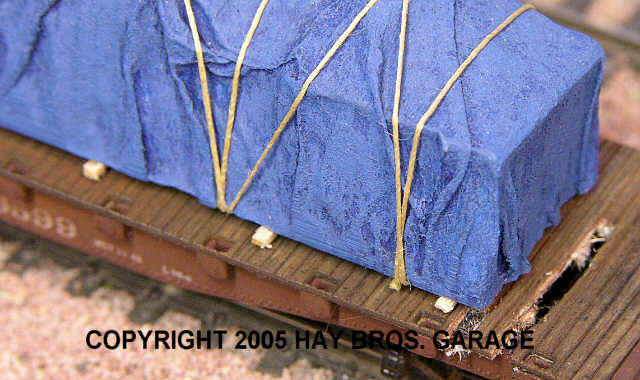
Then add dunnage
strips of wood under the load to support its weight on the car.
Finally, take some thread and tie it around the load, securing it to the
bottom with ACC adhesive.
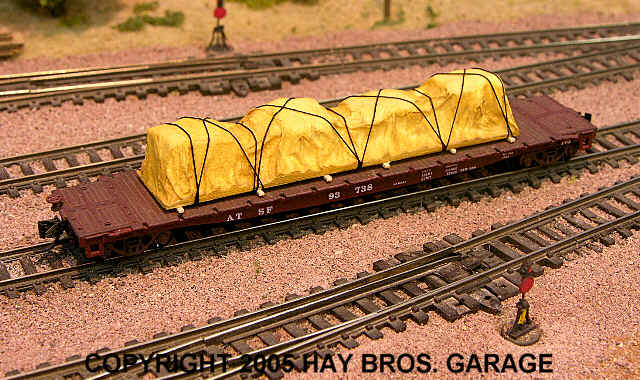
Tip 11: Flatcar with bundled load
I added dunnage
and then wrapped the load in thread to simulate rope holding the canvas cover
down on the load.
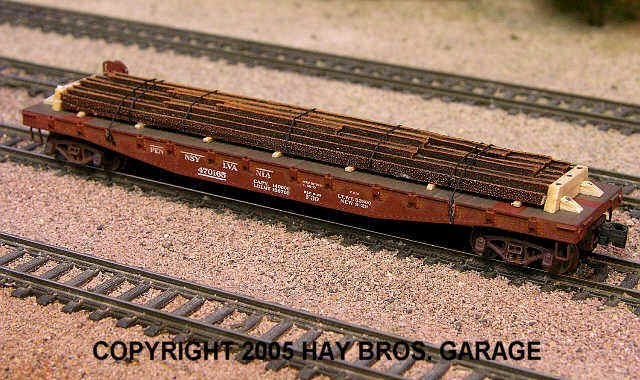
Tip 12: Flat car with steel beam load
Steel beams are
carried on flat cars or gondolas, and are relatively heavy loads.
Usually, the load limit of the car would be exceeded if a gondola were
‘filled’ with heavy steel. Scrap has low weight for its density, but structural steel is
usually shipped in smaller bundles, with straps to retain the load and prevent
shifting. Wood dunnage is placed
under the beams to support their weight while making the car easier to unload.
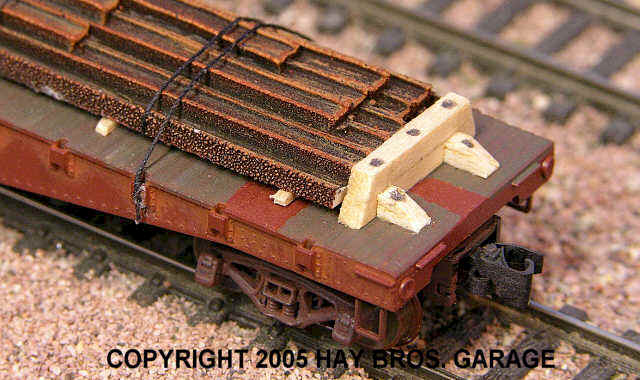
If the load is
traveling more than a short distance, wood blocks are used to prevent the beams
from shifting forwards or backwards in the car. I banded this load of girders with black thread to simulate
the steel bands used on the prototype, and added wood blocks to protect the load
from shifting.
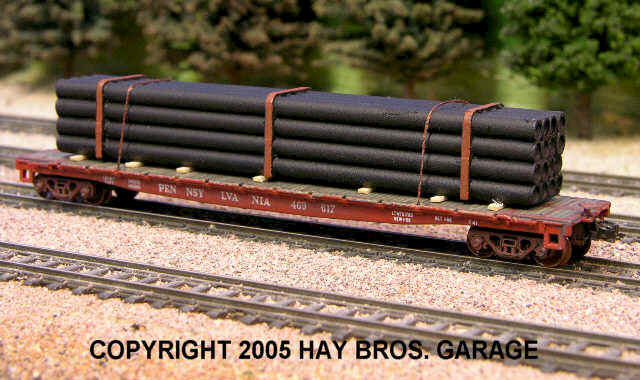
Tip 13: Flatcar with pipe load
Other
commonly-seen loads made by Hay Bros. Garage is their stacks of pipe.
These are shipped on bulkhead or plain flat cars, or on gondola cars.
They come in different stack arrangements and colors, including black,
silver, yellow and blue. I placed
dunnage under the stack, and tied them down with thread.
Box Cars
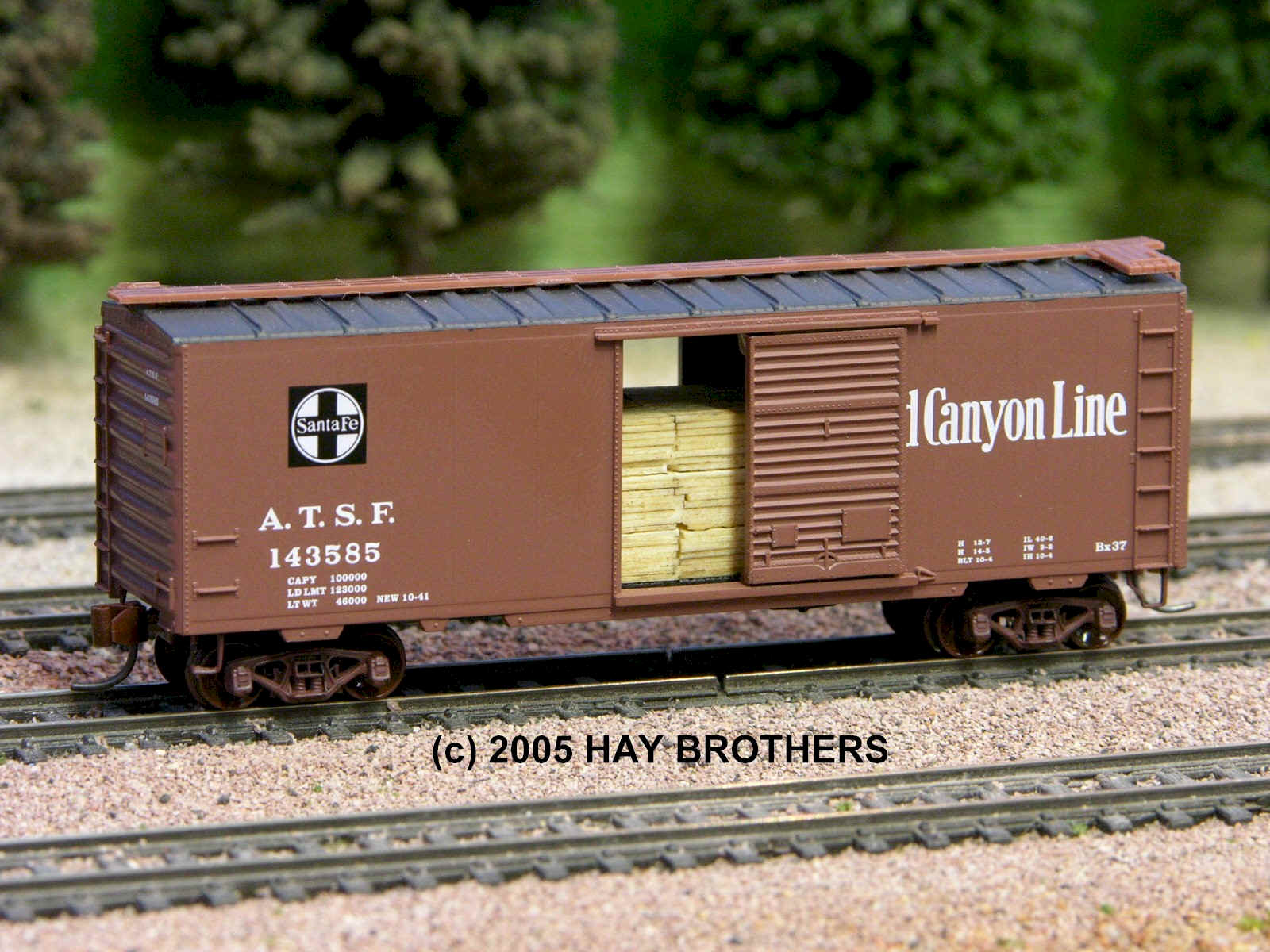
Tip 14: Boxcar with loose lumber load
Box car loads
are usually not visible, but sometimes doors were left open, or you can model
cars in the loading process. Hay
Bros. Garage makes a great load that simulates loose lumber loaded in a box car.
It’s a simple matter of separating the car body from the underframe,
inserting the load in the body, and then replacing the body on the underframe.
This article has
just barely begun to cover all the loads you can build...so it’s time to load
up those empties, and enjoy seeing them hauling freight like their bigger
brothers!
------------------------------------------------------------------------------------------------------------------------------
THIS PAGE LAST UPDATED 06-17-2009
Copyright 2009 Hay Brothers - All rights Reserved